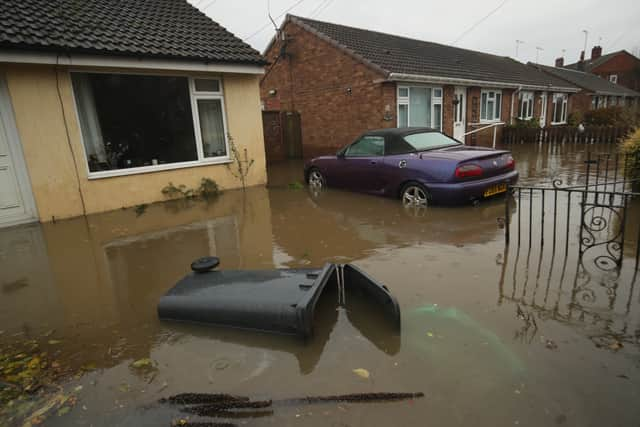Homes in England at risk of flooding set to double in next 30 years as climate crisis worsens
and live on Freeview channel 276
Thousands more homes in England could be at high risk of flooding in the coming decades unless action is taken, government advisers have warned.
The number of homes and properties at risk of flooding could rise from 325,000 today to 600,000 in the next 30 years, according to a new report from the National Infrastructure Commission (NIC).
Advertisement
Hide AdAdvertisement
Hide AdThe report said action is needed to reduce the risk of surface water flooding as climate change is bringing more intense and frequent heavy downpours, while new development’s are putting more pressure on drainage systems.
Stricter controls on new property developments, along with around £12 billion in investment in drainage systems is needed over the next 30 years to prevent thousands more homes and businesses from flooding. There also needs to be more of a focus on “nature-based” solutions such as roof gardens, green gullies, drainage ponds and rain gardens to tackle the problem, the NIC said.


Why are more properties at risk of flooding?
At present, 325,000 English properties are at a high risk from surface water flooding, with a 60% chance of being flooded in the next 30 years.
A combination of climate change, bringing more intense and frequent heavy rainfall, and increased pressure on drainage caused by new developments could see as many as 230,000 more properties in the high risk category by 2055, the report said.
Advertisement
Hide AdAdvertisement
Hide AdThe report added that the unplanned spread of impermeable surfaces, such as the paving over front gardens, which reduces the ability of rainwater to seep away into the ground, could put a further 65,000 properties into high risk areas.
The Commission said that localised floods across England in October, as well as the major flooding incidents in London in last year which affected 1,500 properties and hit hospitals and public transport, highlighted the risks posed by surface water flooding.
It occurs when there is too much rain for drains to cope with and the ground to soak up, filling streets with water which can flood into buildings and disrupt infrastructure.
‘We need to start taking this type of flooding far more seriously’
Following the report, the government is being urged to strengthen legislation and standards for new developments to reduce the use of existing drainage systems for surface water run-off, and increase sustainable measures such as green gullies and flood storage ponds.
Advertisement
Hide AdAdvertisement
Hide AdThe NIC said ministers also need to review options for managing the growth in paved surfaces, and act on expanding drainage capacity and better maintaining existing systems which will improve the resilience of towns and cities to more frequent downpours.
Lower-cost, above-ground measures such as grassy channels, rain gardens and ponds, should be considered before digging more pipes and sewers, the report said.
Professor Jim Hall, National Infrastructure Commissioner, said: “It’s clear that faced with more intense rainfall and increased urbanisation, we need to start taking this type of flooding far more seriously. The solution is clear - reducing the amount of water flowing into drains, whilst also improving the capacity of those drains.
“That means stopping urban creep from increasing the amount of storm water that drainage systems have to cope with and giving nature more opportunities to hold on to excess water, as well as targeted investment to ensure sewers can cope with growing pressures. While sustained investment is needed, the estimated additional costs are relatively modest. At least as important is a more joined-up approach to owning and acting on the problem.”
Advertisement
Hide AdAdvertisement
Hide AdThe commission has recommended that there needs to be a more joined-up and targeted governance for the issue. Local authorities and water companies should work together to develop plans that deliver locally-agreed targets with funding devolved to local areas, and the Environment Agency needs to be actively involved in assessing flood water risk with the government setting national risk reduction targets.
The new infrastructure involved will cost an estimated £12 billion, spread over 30 years, split between public and private funding from water companies. The investment could move 250,000 properties out of the high risk category for surface water flooding, and boost protection for many more.
A government spokesperson said: “We are tackling surface water flooding through our £5.2 billion flood defence programme, with over 30% of 2,000 new flood defences, including sustainable drainage systems, set to improve surface water management. The government has completed a review about mandating sustainable drainage systems in new developments, with more information set to be published shortly.
“This will help address both surface and sewer flooding, alongside our Storm Overflows Discharge Reduction plan, which requires water companies to deliver their largest ever infrastructure investment of £56 billion to tackle storm sewage discharges. We will closely consider the findings of the NIC’s report ahead of publishing our response in 2023.”
Comment Guidelines
National World encourages reader discussion on our stories. User feedback, insights and back-and-forth exchanges add a rich layer of context to reporting. Please review our Community Guidelines before commenting.
